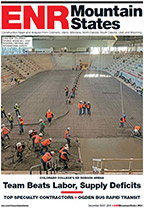For asbestos-abatement contractors, another trend has meant a surge in their business: The conversion of older buildings to residential. “Asbestos has been used in building materials for hundreds of years, but [it was] banned 35 years ago, so there’s a lot of abatement to be completed. Also, a strong economy generates redevelopment, which, in turn, creates high demand for asbestos abatement,” says Ron Daniel, CEO of ARC Abatement.
Staff Shortages Starting To Appear
The one issue that has most specialty contractors on edge is the prospect of shortages in the field and in the office. Many firms say they have not yet been hit with staffing shortages but think it is only a matter of time.
The scale of the problem is not yet known, but many firms already are taking action. For example, Safway Group Holding expects the Gulf Coast market to begin ramping up again. So, it is seeking all levels of personnel in scaffolding, insulation, fireproofing and coatings and, in the coming months, is looking to hire between 3,000 and 7,000 people in the Gulf region alone. “Recently, we opened a new state-of-the-art-hiring center in Houston to help us achieve our objectives,” says Hayes of Safway. “By offering top pay, training and benefits, we hope to attract and maintain the best customer-centric team in the market.”
The field-worker shortages already have had an impact on many firms. “Our pursuit of new project opportunities has been altered by these shortages, and, in some cases, we have decided not to pursue a project due to concerns we may not be able to provide sufficient field labor,” says Chadwick of MMC Corp.
Potential worker shortages and wage escalation have many contractors worried about how to price a job. For example, John Boncher, CEO of Cupertino Electric, notes that the hot California construction market is nearing full employment. “A booming market means that the electrical projects being bid today will be built with electricians transplanted from other locations,” he says. “Some competitor bids that we’re seeing have surprisingly tight numbers, which is risky, considering the future labor pool is unknown. We are actively pursuing new projects but are focused on making sure that we are properly factoring risk into our bids for future work.”
Many contractors worry that a severe skills shortage will result in contractors raiding each other’s workforces. “There will always be people who will be ready to move to another firm for an extra 20%, but, more often than not, they end up regretting it,” says Guzzi of EMCOR. “There is always a home at EMCOR for great people. You have to treat people well in the bad times as well as the good times, and that is how we operate,” he says.
“We can’t treat [staffing] issues like a zero-sum game,” says Jeff VanderLaan, CEO at Kent Cos. “The labor wars used to be about pay rates, benefits and recruiting from competitors across the street. Today, it’s about building the next generation of talent.”
Some firms have tried interesting recruiting methods. For example, Long Painting Co. hired a former Army captain to head up its recruiting effort, targeting veterans. “With the military reduction, we have found a source of higher-caliber individuals that are disciplined, motivated and eager to learn a new trade,” says Jeff Engle, Long’s business development manager.
The increase in demand for craft workers has had an effect on wages. “Labor cost is increasing—and rightfully so. All of our crews have worked hard since the recession, and they deserve the increases they have received. Fortunately, the market is allowing us to increase our billing rates accordingly,” says Christopher Jordan, president of Johnson and Jordan.







Post a comment to this article
Report Abusive Comment